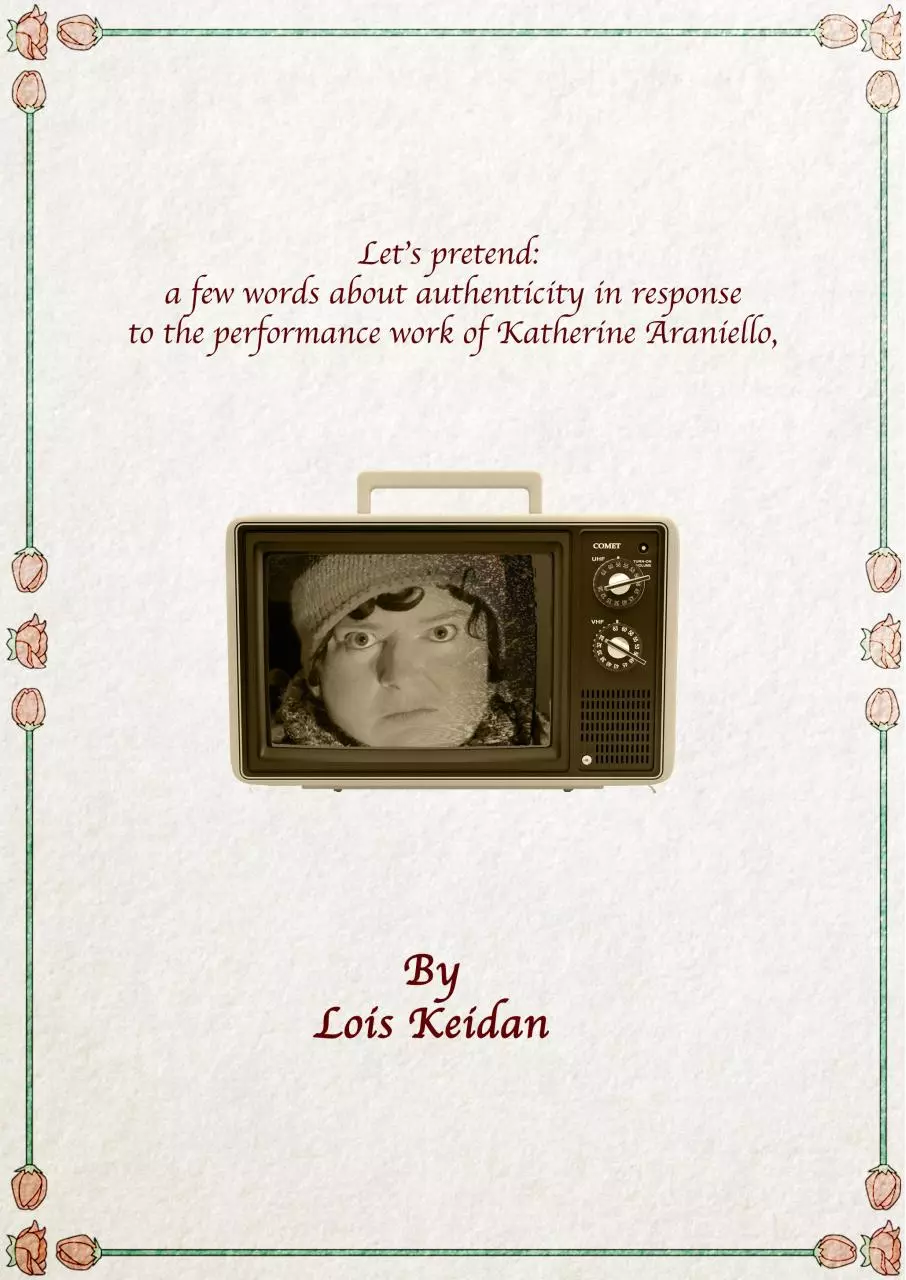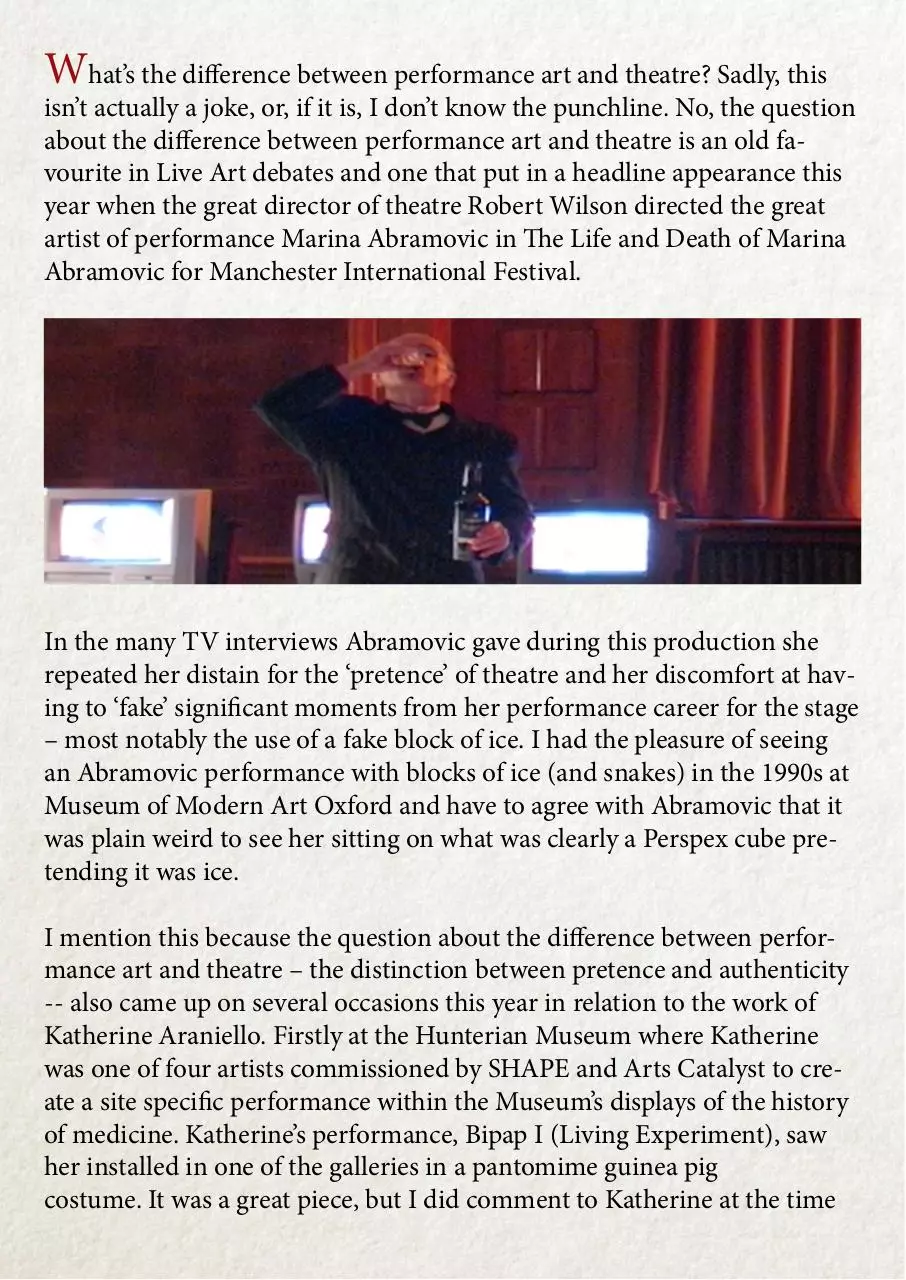The Diner Party (PDF)
File information
This PDF 1.4 document has been generated by Adobe InDesign CS6 (Macintosh) / Adobe PDF Library 10.0.1, and has been sent on pdf-archive.com on 09/03/2014 at 13:26, from IP address 37.152.x.x.
The current document download page has been viewed 1323 times.
File size: 8.26 MB (23 pages).
Privacy: public file





File preview
What’s the difference between performance art and theatre? Sadly, this
isn’t actually a joke, or, if it is, I don’t know the punchline. No, the question
about the difference between performance art and theatre is an old favourite in Live Art debates and one that put in a headline appearance this
year when the great director of theatre Robert Wilson directed the great
artist of performance Marina Abramovic in The Life and Death of Marina
Abramovic for Manchester International Festival.
In the many TV interviews Abramovic gave during this production she
repeated her distain for the ‘pretence’ of theatre and her discomfort at having to ‘fake’ significant moments from her performance career for the stage
– most notably the use of a fake block of ice. I had the pleasure of seeing
an Abramovic performance with blocks of ice (and snakes) in the 1990s at
Museum of Modern Art Oxford and have to agree with Abramovic that it
was plain weird to see her sitting on what was clearly a Perspex cube pretending it was ice.
I mention this because the question about the difference between performance art and theatre – the distinction between pretence and authenticity
-‐ also came up on several occasions this year in relation to the work of
Katherine Araniello. Firstly at the Hunterian Museum where Katherine
was one of four artists commissioned by SHAPE and Arts Catalyst to create a site specific performance within the Museum’s displays of the history
of medicine. Katherine’s performance, Bipap I (Living Experiment), saw
her installed in one of the galleries in a pantomime guinea pig
costume. It was a great piece, but I did comment to Katherine at the time
that I didn’t think her guinea pig noises were right (I think guinea pigs
chunder rather than squeak). I was vof course being facetious and the
point was that Katherine was not pretending to be, or acting as, a guinea
pig, but was being the artist in a guinea pig costume making a point about
scientific experimentation and how the medical profession sometimes treat
patients as infantile especially if they have an obvious disability.
And so to The Dinner Party. This was another great Araniello piece and
one of the many, many things that made it for me was again its authenticity – its lack of pretence – as beautifully illustrated in her collaboration with
the artist Ernst Fisher in the role of the butler. Whilst theatre tends towards a tightly structured, heavily rehearsed rendition of a narrative or set
of ideas that is often repeated verbatim night after night, Live Art/Performance Art is more of a concept or framework in which ideas are explored
and possibilities can unfold. And within the concept and framework of
The Dinner Party Ernst drank every drop of every drink he poured for
Katherine’s dinner guests (appearing on monitors)*. His descent into a
drunken stupor throughout the performance was as authentic as it gets,
and something that simply wouldn’t have worked (for me at least) if there
hadn’t been real alcohol in the bottles and if he’d only ‘acted’ drunk. In fact
the piece’s intentional collapse of all kinds of rules and roles was extraordinary, particularly the moment when Marja Commandeur, Katherine’s
PA who was there simply to facilitate, started drinking along with Ernst,
despite Katherine’s protestations -‐ a sublime moment of controlled performance chaos.
So one of the answers to the question of the difference between performance art and theatre could be “go and have a look at the work of Katherine Araniello”.
* Katherine also genuinely drank every drop that came her way, but didn’t
knock them back as quickly as Ernst!
Shannon Murray, the Debenham’s model, is asked about her beauty, and
whether or not she feels she is representative of disabled people. It is a
strange question to wake up and hear. The interview on radio 4, broadcast
on 29 August 2011, was articulate and bright. It was a polite awakening for
me, and I listened with great concentration to the delightful voice tell of
the diving accident which severed her spinal cord and put her in a wheelchair. We who are not disabled are only provisionally able-‐bodied – that is
the implication and reminder here. The language around disability is rightly cautious, but this does not stop the brainy lawyer-‐turned-‐ model and
actress from citing her dark sense of humour as one of the greatest weapons in battling the forces of prejudice and fear.
Here I want to consider the great, resistant humour of Katherine Araniello.
The GSOH has always been a particularly odd but often-‐cited desirable
attribute. By the time I myself had become suspicious of the sense of humour as something entirely subjective and susceptible to power-‐play, I
was already aware of semiotics, social constructions and that slippery entity of difference called the other. Before that, I remember an age when I was
in the dark and hadn’t a clue as to how I was being entertained.
I laughed at The Party, a Blake Edwards film with Peter Sellers playing an
accident-‐ prone Indian man, till I fell convulsing with mirth on the cinema floor. At the time of its release, I was 10 years old and it was 1968.
When I saw the film again recently, while cringing at the crude brown
grease paint, I was surprised to find myself actually moved by a scene in
which Sellers’ character laughs at the punchline to a joke he hasn’t heard.
He makes a show of enjoying it because he can see that the invited guests
are very amused. He has not been invited, but is keen to be a perfect guest
– an ambition which is of course unfulfilled in one calamitous episode
after another. But I can identify with him now, whoever and whatever this
performed other was, or is, because his image, frozen in celluloid, has endured unchanged through all the changes of the intervening ages.
It was common for children of my age to laugh at funny accents, to collect
golliwogs from jam jars, and to put money in the Spastic Society’s collection box without a second thought. I remember the enameled boy with
glossy dark hair, wearing blue shorts so you could see the caliper on his
leg. He was a very good looking boy, making the caliper somehow attractive to me. In 1986, the society – now renamed SCOPE – began to withdraw these donation boxes and replace them with Care Bears or some
such.
When Katherine Araniello discussed her Artsadmin bursary with Manick
Govinda, there was mention of a mentor and Katherine was given a list of
names. I was one of these. She later told me she chose me because I was
older. We laughed. I think I could call this essay Oh We Larfed, because
we seriously did. It’s a serious business though to be a child left outside a
shop, while your mother hurries in on an errand, only to find coins being
dropped in your living lap by well-‐intentioned passers-‐ by. Maybe only
someone who remembers putting money in ‘the boy from the chemist’, to
partially quote from the title of Kerry Stewart’s 1993 installation, would
understand the particularities of some of Katherine’s accounts.
It was in the stories that Katherine told me that I learned more and more
about the inadvertent menace of the well-‐intentioned. There are those
who want to hug her and then look hurt at her lack of enthusiasm. These
are potentially very time consuming, because the unravelling of spurned
do-‐gooders can be long-‐winded and painfully tedious. Then there are
those who talk to her assistant, suggest a treat and slip a tenner into the
hand of the carer. And of course there are those who ask compassionately
Download The Diner Party
The Diner Party.pdf (PDF, 8.26 MB)
Download PDF
Share this file on social networks
Link to this page
Permanent link
Use the permanent link to the download page to share your document on Facebook, Twitter, LinkedIn, or directly with a contact by e-Mail, Messenger, Whatsapp, Line..
Short link
Use the short link to share your document on Twitter or by text message (SMS)
HTML Code
Copy the following HTML code to share your document on a Website or Blog
QR Code to this page

This file has been shared publicly by a user of PDF Archive.
Document ID: 0000150789.